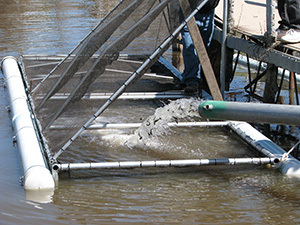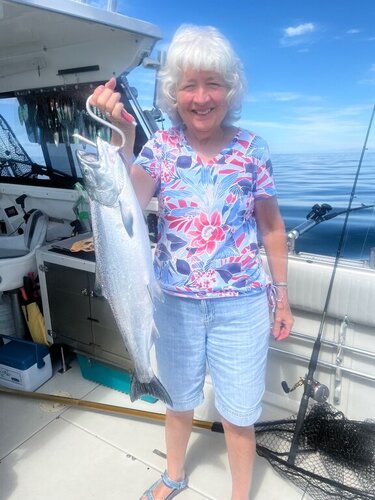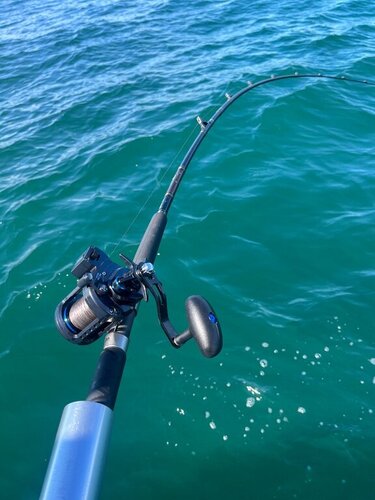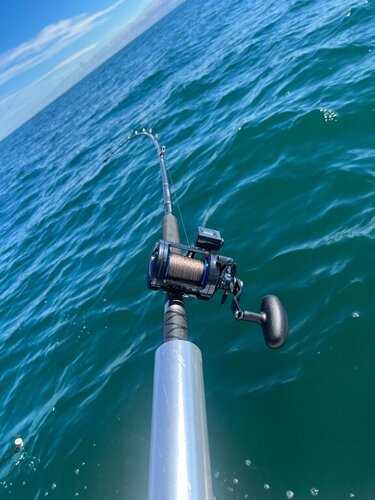-
Posts
508 -
Joined
-
Last visited
Content Type
Profiles
Forums
Events
Gallery
Store
Posts posted by mudflat
-
-
Glen
i will take it at 150 plus shipping to 18436
Pm me the total and I can send you $ PayPal or mail you a check
thanks
Roy
-
Nice boat but it is not a Pro Hunter -- It is a 255 Intruder
Also check the pictures because that is not at Wright's
-
https://seaqualizer.com/product/seaqualizer-descending-device/
I have a Seaqualizer ready, hook it to a down rigger and send them back down slowly. I hope getting them back down to colder water helps revive them
-
 1
1
-
-
Lake Ontario Fishing Boat Survey Results - Spring 2023
 Lake Ontario provides anglers with a diverse world-class trout and salmon fishery worth an estimated $560 million dollars to NY's economy.
Lake Ontario provides anglers with a diverse world-class trout and salmon fishery worth an estimated $560 million dollars to NY's economy.
According to anglers surveyed this spring, there were:
- Above average Chinook salmon fishing in the west and east central lake areas in April and early May with unfavorable winds and slower fishing later in the reporting period;
- Slightly above average brown trout fishing in east central and east lake areas;
- A noticeable lack of larger-sized browns lake-wide;
- Lower lake trout catch rates in 3 out of 4 lake areas, and below average catch rates in the west central area for all species; and
- Lower numbers of lamprey observed compared to record highs in 2022.
Copy of full report: Lake Ontario Fishing Boat Survey, Spring 2023 Report (ny.gov)
-
19 hours ago, pfu said:
Not sure I follow. The Velcro on a stick is easy but do you sandwhich the two sticks together and slide over the fleas on your line?
You just use one stick and rub the velcro across the fleas on your line as you bring it in. The velcro will grab the fleas and not damage your line. The tighter your line is the better it works. You can wash the fleas off the velcro with your wash down hose.
-
NYS Regulations:
Fish cleaning
• All legally harvested fsh may be gilled or
gutted while on the water.
• Possession of the following fsh that
have been cut, dismembered, flleted,
skinned, or otherwise altered so that
the species and total length of such
fsh cannot be easily determined is
prohibited:
⊲ Walleye,
⊲ Black Bass,
⊲ Brook trout,
⊲ Lake trout, and
⊲ Atlantic salmon.
• Other species of fsh may be flleted
provided that the skin is not removed
from the fllets.
Fish carcass disposal
It is illegal to discard any fsh carcass, or
parts thereof, into the freshwaters of the
state within 100 feet of shore or upon any
public or private lands contiguous to and
within 100 feet of such water, except:
• On private lands by the owners of such
lands;
• If properly disposing into suitable
garbage or refuse collection systems or
by burial;
• Where incidental cleaning of fsh for
consumption is permitted. However,
resulting waste may not be disposed of
within 100 feet of any public launching or
docking site unless into a suitable refuse
collection system; and
• Fish required to be returned to the water
by regulation or law.
74 New York State Freshwater Fishing Regulations Guide 2023I thought I read somewhere that you also weren't suppose to filet steelhead on the lake because of the 21" minimum size regulation.
-
Dry docking will save you fuel cost of towing depending on how far you travel. I had a 4 hour tow and it was less expensive to pay the marina fee but that would also depend on how often you fished.
It was also much more convenient to dry dock because I didn't have to pack up everything completely each time, all I had to do was take down the rods and put on the cover.
The downside is your boat isn't at your home so you can't work on it between trips and there might be security issues depending on the area. You also have towing issues, ie. slower speeds, flat tires, more stressful driving, ect. . The larger the boat the more problems.
I towed for years and then dry docked for a few. Now I keep her in a slip and wouldn't want to go back to towing every trip.
-
Sammy, use the "hook" side
There's a couple on my boat next to the throttle control if you want to borrow one to try
Works well even with a fish on, doesn't damage the line.
-
DEC Delivers - Information to keep you connected and informed from the NYS Department of Environmental Conservation
DEC and Local Partners Host Public Meetings About Lake Ontario
Meetings Scheduled for June 6 in Rochester, June 21 in Mexico
DEC Fisheries Staff to Share Current State of Lake Ontario Sport Fisheries
New York State Department of Environmental Conservation (DEC) Bureau of Fisheries Chief, Lake Ontario Unit Leader, and respective regional fisheries managers will be on-hand at two upcoming public meetings hosted by DEC partners in Rochester and Mexico. DEC experts will talk about the current state of the Lake Ontario sport fisheries and take questions on a wide array of management actions and research taking place on the lake and tributaries. At the meetings, interested anglers will have the opportunity to speak directly with staff after a brief presentation.
The Lake Ontario Charter Boat Association is hosting the first public meeting in DEC's Region 8, which is comprised of Chemung, Genesee, Livingston, Monroe, Ontario, Orleans, Schuyler, Seneca, Steuben, Wayne, and Yates counties.
What: Lake Ontario Sport Fishery Public Meeting
When: June 6, beginning at 7 p.m.
Where: Irondequoit Fish and Game Club, 658 Bay Front S, Rochester, NY 14609The Eastern Lake Ontario Salmon and Trout Association is hosting the second meeting in DEC's Region 7, which is comprised of Broome, Cayuga, Chenango, Cortland, Madison, Onondaga, Oswego, Tioga, and Tompkins counties.
What: Lake Ontario Sport Fishery Public Meeting
When: June 21, beginning at 7 p.m.
Where: VFW Hall, 5930 Scenic Avenue, Mexico, NY 13114For more information contact Chris Legard, Lake Ontario Unit Leader, at 315-654-2147 or email: [email protected].
Lake Ontario anglers, and all fishing enthusiasts, are encouraged to check out DEC's 'Tackle Box' feature in the HuntFishNY App, which provides anglers one-stop shopping for waterbody-specific information on fishing regulations, stocking, and fishing/boating access sites.
The New York State Department of Environmental Conservation respects your right to privacy and welcomes your feedback | Update preferences or unsubscribe | Learn more about DEC DeliversConnect with DEC: http://content.govdelivery.com/attachments/fancy_images/NYSDEC/2015/07/565841/facebookicon_original.jpg

 http://content.govdelivery.com/attachments/fancy_images/NYSDEC/2015/07/567473/youtubeicon_original.jpg
http://content.govdelivery.com/attachments/fancy_images/NYSDEC/2015/07/567473/youtubeicon_original.jpg 

Basil Seggos, Commissioner
-
 1
1
-
-
-
I used a 50# Spro power swivel size 8
-
I used a small spro swivel between the wire and 40# mono when I set up a slide diver but that was with a twili tip. I am not sure how a swivel would work with a roller tip? Maybe try an Albright knot
-
Chinook Salmon Stocking Targets Increased for 2023
 DEC and the Ontario Ministry of Natural Resources and Forestry (OMNRF) have agreed to a 10% increase in Chinook salmon stocking in Lake Ontario this year. We have been adaptively managing the number of salmon and trout stocked in Lake Ontario, since 2016, based on the alewife biomass and Chinook salmon growth and condition. In 2022, the age-2 and older alewife biomass increased and is predicted to remain at similar levels in 2023 and 2024 (see below for a full report prepared by USGS). The average weight of an age-3 Chinook salmon increased to 20.7 pounds in 2022 and remained above the lower threshold of 18.4 pounds.
DEC and the Ontario Ministry of Natural Resources and Forestry (OMNRF) have agreed to a 10% increase in Chinook salmon stocking in Lake Ontario this year. We have been adaptively managing the number of salmon and trout stocked in Lake Ontario, since 2016, based on the alewife biomass and Chinook salmon growth and condition. In 2022, the age-2 and older alewife biomass increased and is predicted to remain at similar levels in 2023 and 2024 (see below for a full report prepared by USGS). The average weight of an age-3 Chinook salmon increased to 20.7 pounds in 2022 and remained above the lower threshold of 18.4 pounds.
As a result, DEC will stock 985,180 Chinook salmon in 2023 – an increase of approximately 90,000 over 2022. The additional fish are being spread evenly across the stocking sites listed in the Lake Ontario salmon and trout stocking strategy, except the Salmon River stocking numbers will remain the same as in 2022 (serving and the water for hatchery broodstock, it already receives higher numbers than the other stocking locations).
2023 Chinook salmon stocking targets (Location, Number stocked)
- Niagara River - 89,930
- Eighteenmile Creek (Olcott) - 126,330
- Oak Orchard Creek - 126,330
- Genesee River - 126,330
- Oswego River - 126,330
- Salmon River - 300,000
- Sackets Harbor (Black River) - 89,930
Adaptively managing the number of salmon and trout stocked in Lake Ontario ensures we maintain a predator prey balance and continue to provide world-class fishing opportunities for years to come.
Lake Ontario April prey fish survey results and Alewife assessment, 2022 (PDF)
Lake Ontario Salmon and Trout Stocking Strategy- 2022-2026 (PDF)
-
 1
1
-
30 minutes ago, Yankee Troller said:
What questions do you have about Fish Hawk? We've run the Fish Hawk X4D for a few years now.
Stay tuned is all I'll say

Edited September 9 by Yankee Troller
-
Thanks Rick, have you used the paddle wheel for speed?
Do you have any info about Fish Hawk that you would be willing to share?
I have the original Smart Troll and I agree with you 100%. When it worked the info was very valuable but the reliability of the system wasn't very good. One by one my probes quit working, probably related to the batteries. When my last probe died this year I really missed the info, especially on my divers. I am thinking about upgrading to the new version but haven't found many reviews on it out there. I'm still concerned about the reliability and the batteries holding up. I am surprised Darrell doesn't offer a "smart charger" or replaceable batteries.
-
Anyone have any experience with the newer version Smart Troll ll?
I’m familiar with the original version and am wondering how much improvement the newer version is .
Also wondering if anyone knows what Fish Hawk has coming???
Thanks
-
 2
2
-
-
I had Hank replace my sea water pump this spring and said that I must be using the cheap stuff to winterise because my impeller was soft and swollen.
I never knew that there was a difference and just got what was easy to find. Learned something new.
Thanks for the reminder
-
 1
1
-
-
I've used one for several years. I have four riggers and usually only run three when fishing deep so I leave the seaqualizer attached to the 4th rigger, hook them up and send them down. Quick and easy
I don't know how much it actually helps survival rate but it's better than watching them float behind the boat in the warm water. I've also used it for shakers that look tired out.
-
Fished with my wife so we didn’t set lines till 9 am but we still found fish, Started at 150 fow and headed North, Temp was down 95 to 100”. Most of our fish came between 200 and 250, found fish all the way out to 500. Meat rig on a swr down 100 and sushi flies on a 240 dipsy on a 2.5 setting. New Saltist reels worked great.
Ended up with 6 in the box, 3 shakers and 1 lamprey which made my wife very unhappy.
-
 7
7
-
-
Finally received 2 new Saltist 30 line counter reels and it was worth the wait


Spooled them up with 30lb wire, 1000 feet fit fine. Smooth drags and no line counter digging into my arm. Handles similar to the old 47”s but much better quality. Drags are better than my tournament drags. Gave them a workout today and they did not disappoint me.
This could get expensive
-
 1
1
-
-
FollowView Profile
Angler Lands Heaviest Chinook Salmon Caught in Wisconsin Since 1994
Bob McNally - Yesterday 6:18 PMReact5 Comments|52Support journalism-
Share
-
Save

This summer, Minnesota angler Brian Sollars was fishing Lake Michigan for just the second time. But he was in the right place at the right time aboard the Wisconsin-based charter boat Midnight, captained by Bill Classon with mate Carter Zimmerman.
At about 6:15 a.m. on July 31, a heavy fish slammed a Moonshine spoon trolled from the Midnight. The spoon was 50-feet deep off a downrigger in about 160 feet of water, according to a Facebook post by Kinns Sport Fishing, a charter boat operation based out of Algoma, Wisconsin.
“It was funny—I didn’t feel anything but weight at first,” Sollars told the Door County Pulse. “I told Bill and Carter it was weeds, but then it took off on a long run.”
Sollars’ arms started aching during the fight, and for a time he thought the fish would take all the line on his reel and escape.
Related video: Running a Commercial Salmon Fishing Business in Alaska
they have to travel, the more fat they store. So the reason CopperPlayLoaded: 19.08%Current Time 0:48/Duration 9:58HQCaptionsFullscreenRunning a Commercial Salmon Fishing Business in AlaskaUnmute0“Just looking at that line disappear, it looked like it was going to be about gone,” Sollars said. “I was hoping the fish would stop running at some point, and it did, and I was able to make some progress.”
It took about 15 minutes of hard work battling the huge Chinook, but Sollars slowly worked the salmon close to the “Midnight” boat and first mate Zimmerman netted the giant Chinook, or king salmon, and brought it into the boat.
The big salmon measured 44 inches long.
The fish is perhaps a “wild” salmon, according to Kinns, because it didn’t have a clipped adipose fin. Such fins commonly are clipped by hatchery workers when stocking salmon to indicate their origin. Since Chinook salmon have been shown to spawn naturally in Lake Michigan, Sollars’ fish may have been a naturally produced salmon, according to USFWS data on Chinnoks in the lake.
Sollars’ huge fish measured 44 inches long, with a 28.5-inch girth. It weighed 40.40 pounds on certified scales, or 40 pounds, 6.4 ounces.
The fish is the heaviest recorded Chinook in the Wisconsin waters of Lake Michigan since the state record 44-pound, 15-ounce salmon was caught in July 1994 out of Sturgeon Bay. That fish measured 47.5 inches long.
On certified scales, a true “40-pound” Wisconsin Chinook is rare, according to Kinns Sport Fishing, which has run many thousands of Lake Michigan salmon charters over the decades.
-
 3
3
-
-
Copied from NYS Regulations
Regulations of Harvested Fish
Fish Cleaning
- All legally harvested fish may be gilled or gutted while on the water.
-
Possession of the following fish that have been cut, dismembered, filleted, skinned, or otherwise altered so that the species and total length of such fish cannot be easily determined is prohibited:
- Walleye,
- Black Bass,
- Brook trout,
- Lake trout, and
- Atlantic salmon.
- Other species of fish may be filleted provided that the skin is not removed from the fillets.
Fish Carcass Disposal
It is illegal to discard any fish carcass, or parts thereof, into the freshwaters of the state within 100 feet of shore or upon any public or private lands contiguous to and within 100 feet of such water, except:
- On private lands by owners of such lands;
- If properly disposing into suitable garbage or refuse collection systems or by burial;
- Where incidental cleaning of fish for consumption is permitted. However, resulting waste may not be disposed of within 100 feet of any public launching or docking site unless into a suitable refuse collection sys tem; and
- Fish required to be returned to the water by regulation or law.
It's OK to fillet salmon, steelheads and browns on the water but not lakers or atlantics.
I do see a lot more boats with cleaning stations these days coming in slow with a lot of gulls following them in?
-
If you get to Arney’s my Intruder is docked out by the gas pumps if you want to look it over
-
There’s a free public launch at Sodus on Rte 14 or you can launch at either Bay Bridge or Tide Sides Marina ( Arney’s)
for a fee. There is a cleaning station at Arney’s that I think you can use if you launch there





2023 Lake Ontario Creel Survey Summary - Another Great Year of Fishing on Lake Ontario!
in Open Lake Discussion
Posted
The Fishing Line - December 29th Issue
In this issue:
DEC Fisheries – 2023 Year in Review
Check out the list below for some highlights and noteworthy items from the past year here in the Bureau of Fisheries. 2024 already looks to be a very productive year!
This past spring, over 320 lake trout were captured throughout the lake and tagged with acoustic transmitters to track their movements and pinpoint spawning locations in the fall. To quantify current habitat quality, biologists are also using video to map bottom habitat at thousands of potential spawning locations across the lake. Watch the sample video (6 MB)... and...wait for the lucky shot at the end.... I guess they nailed that one!
2023 Lake Ontario Creel Survey Summary - Another Great Year of Fishing on Lake Ontario!
The Lake Ontario creel survey recently wrapped up another season, and preliminary results indicate:
More details can be found in the survey’s monthly reports posted on the Lake Ontario Fisheries Management and Research page, and the full survey report will be available in early 2024. The Lake Ontario creel survey continues in the tributaries from now until next spring, so be on the lookout for DEC creel agents and reports in the coming months.
Hatchery Highlight – Adirondack Fish Hatchery
Location: 103 Fish Hatchery Road, Saranac Lake, Franklin County
Visitor Hours: 9:00AM - 3:30PM, 7 days a week, from April 1 to October 31
Species Raised: Landlocked Atlantic salmon and round whitefish
Overview: Constructed in 1885, the Adirondack Fish Hatchery is situated in the beautiful Adirondack Mountains several miles northwest of the Village of Saranac Lake. The site was selected in 1884 due to its premiere location near a consistent flow of cool, clean water from Little Clear Pond and easy access to a railroad and telegraph and telephone lines. In later years, the hatchery created four wells to bring in warmer water during the winter months to speed up egg and fish development of select species. Historically, the hatchery raised multiple trout and salmon species, but today the main activities that take place here include:
Fun Fact: The Adirondack Fish Hatchery is the only hatchery in New York State that specializes in breeding the endangered round whitefish for stocking in waters they historically inhabited, as well as the only DEC hatchery to raise native landlocked Atlantic salmon for stocking in waters from the Adirondacks to the Catskills, Finger Lakes, and Lake Ontario.
Learn more about DEC Fish Hatcheries